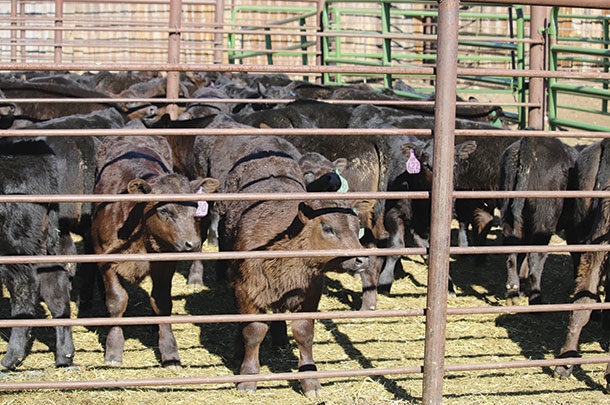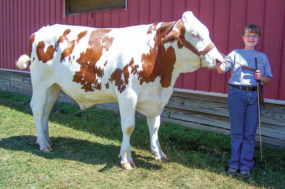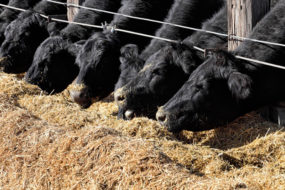In December 2018, McDonald’s announced their plan for an unprecedented global antibiotic use policy for their beef suppliers, driving responsible use of antibiotics by monitoring and reducing usage over the coming years.
Various associations, including the Food and Agriculture Organization of the United Nations (FAO) and the Center for Disease Control and Prevention (CDC), consider antimicrobial resistance (also referred to as “antibiotic resistance” or “drug resistance”) to be one of the biggest public health concerns the world is currently facing.
These organizations, as well as the FDA, are developing regulations to help address concerns that livestock production is potentially contributing to the development of antimicrobial resistance.
What is antimicrobial resistance, and why are livestock producers under such scrutiny? First of all, some definitions:
- Antimicrobial: Substance that can destroy or prevent the growth or multiplication of micro-organisms.
Various types of antimicrobials exist and are differentiated by their targeted micro-organism: bacteria (antibacterial), fungi (antifungal), viruses (antiviral), protozoa (antiprotozoal), etc. Antimicrobials also include disinfectants such as alcohol and bleach.
- Antibiotic: Antimicrobial substance that can destroy or prevent the growth or multiplication of micro-organisms, typically limited to those effective against bacteria.
All antibiotics are antimicrobials, but not all antimicrobials are antibiotics. The two terms are often used interchangeably, and some characteristics that differentiate the two are whether the substances are naturally produced by microorganisms or synthetic. Generally speaking, antibiotics are drugs used to treat bacterial infections in humans and animals.
- Antimicrobial resistance (AMR): When microbes, including bacteria, develop the ability to resist the action of antimicrobials. Simply stated: Resistant microbes continue to grow and survive in the presence of dosages of antimicrobial substances that formerly prevented such actions.
This is not a new scientific phenomenon, as AMR occurs naturally, even in the absence of antimicrobial usage. However, there has been a growing interest about the potential for micro-organisms, especially bacteria, to become less susceptible to the substances used to fight infections in both humans and animals.
This is a concern because with antibiotic resistance, illnesses can be more severe, last for longer periods of time and may even result in death due to the lack of an effective treatment. Only a limited number of antibiotics approved for use exist, so when resistance occurs, treatment options rapidly decline and, occasionally, no effective drug is available.
The FDA has implemented several regulations to address antibiotic use in U.S. livestock operations with the goal of preventing the development of AMR of antibiotics of medical importance in human medicine. Under FDA regulations, all medically important antibiotics (those also used in human medicine) which are administered to food animal species via feed or water require a prescription from a veterinarian or a Veterinary Feed Directive (VFD) which specifies how the antibiotic can be administered.
Livestock production has entered the spotlight for its potential role in the development and spread of AMR for a few reasons. One major reason is the historic use of low-dose (sub-therapeutic) antibiotics for production purposes – growth promotion and improved feed efficiency. These low-dose usages of antibiotics are thought to increase the risk of AMR developing on-farm.
This leads to the second concern, in which AMR microbes could be spread to humans through the food chain. Food safety is important to reduce the potential spread, including proper handling, cooking and storage of animal products. Handwashing is critical but is often overlooked – both in the kitchen and on-farm.
Although medically important antibiotics can no longer be fed to promote growth and improve feed efficiency in the U.S., they can still be given under veterinary oversight when there is a clear indication of their need. Below are four uses for antibiotics in animal production:
- Prophylaxis – Administration of antimicrobials to prevent infection when a known disease risk is present
- Metaphylaxis – Administration of antimicrobials to a group of animals when a disease is present in a percentage of the herd in order to limit the spread of disease or prevent an outbreak
- Therapy – administration of antimicrobials to sick animals
- Production purposes – growth promotion or improved feed efficiency à It is illegal to use medically important antimicrobials for production purposes as of Jan. 1, 2017, when the Veterinary Feed Directive went into full effect.
It is important to note ionophores are not used in human medicine and therefore are still approved for production purposes in food animals.
All medications administered to food animals should be done so according to label specifications. Residues in animal products are of particular concern; thus, strict adherence to withdrawal times for meat and milk is essential, as well as proper recordkeeping.
As U.S. livestock production systems adapt to changes in antibiotic tools available, and with concerns of potential additional regulations, innovative strategies are filling the gaps. Additional practices that can be implemented which complement and may help drive responsible antimicrobial use by limiting the need for treatment interventions in livestock include:
1. Vaccination programs
Work with your veterinarian to develop vaccination programs tailored to your herd’s needs. Vaccinations can reduce the incidence, duration or severity of potential infections. Timing of immunization and type of vaccine, as well as what specific diseases are targeted, are all considerations to discuss while designing a vaccination program. Keep in mind: Vaccines are only as effective as the animal’s immune response.
2. Biosecurity
Biosecurity is important in limiting the spread of more common diseases by minimizing the movement of biologic organisms (bacteria, viruses, etc.) and their vectors (infected cattle, flies, rodents, equipment, etc.) onto as well as within your operation. Biosecurity practices in cattle operations are typically much less strict than in swine or poultry facilities. However, some key points to consider include isolation of new animals/minimizing commingling of established groups of cattle, traffic control (for example, monitor who comes on-farm and where they have access) and sanitation is also very important to reduce exposure of animals (as well as humans) to potential pathogens.
3. Limit stress
Limit stress, as stressors reduce immune function and leave animals more susceptible to diseases. If the immune system is not functioning properly, animals will not have adequate response to vaccinations and will still be susceptible to those diseases. High-stress times include:
- Weaning
- Castration
- Any time cattle are handled
- Transportation
Additional factors that can cause stress include:
- Overcrowding
- Poor hygiene
- Heat stress (cold stress)
4. Nutritional considerations
- Balanced diet that supports adequate feed intake
- Feed additives can help promote animal health and increase productivity. Many feed additives are available on the market, but some with potential health or performance benefits include phytogenics or essential oils as well as yeast-based products and probiotics
- Limit and address anti-nutritional factors, including mycotoxins, which can negatively impact immune function and health as well as limit productivity, even at low levels of contamination. Mycotoxins are produced by various molds and can contaminate crops in the field prior to harvest or feeds once they are in storage. Monitoring feeds for contamination is part of a comprehensive mycotoxin risk management program. Cattle often present with non-specific signs during mycotoxin challenges including reduced feed intake, diarrhea, decreased average daily gains and increased incidence of secondary infections such as respiratory disease.
5. Early detection and diagnosis
Ongoing research is identifying biomarkers and test parameters which can be done cowside (chuteside at receiving, for instance) to identify high-risk or animals which are infected but not yet showing clinical signs of illness. Early identification can target treatment to these subclinically infected and high-risk animals which may prevent or limit disease spread in the herd.
This can help drive judicious antibiotic use by limiting administration to those animals with the highest risk of disease. More research is needed to identify such disease markers that are reliable and able to be measured quickly on-farm.
No single product or management practice will completely replace the potential need for antibiotics in livestock rearing because, despite our best efforts, animals still get sick, and those illnesses should be addressed accordingly. Knowing your herd and the potential challenges it may face while working closely with consultants including your veterinarian and nutritionist can provide a holistic animal care approach which can help reduce the occurrence of disease and limit the need for antimicrobial interventions. ![]()
PHOTO: The terminology and health policies involved with antibiotic use can be complicated to understand. But if producers want to protect herds wisely, they must balance antibiotic use with proper monitoring and vigilance. Staff photo.

-
Paige Gott
- Ruminant Technical Manager
- Biomin America Inc.
- Email Paige Gott







